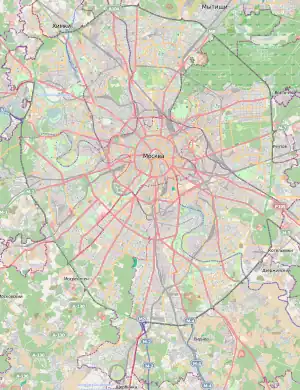Moscow Kiyevsky | |||||||||||||||||||||
|---|---|---|---|---|---|---|---|---|---|---|---|---|---|---|---|---|---|---|---|---|---|
| Moscow Railway terminal | |||||||||||||||||||||
 View of the main facade from Europe Square | |||||||||||||||||||||
| General information | |||||||||||||||||||||
| Location | 1, Kiyevskogo Vokzala sq. Moscow Russia | ||||||||||||||||||||
| Coordinates | 55°44′35″N 37°34′02″E / 55.743056°N 37.567222°E | ||||||||||||||||||||
| Line(s) | Kiev Line | ||||||||||||||||||||
| Platforms | >10 | ||||||||||||||||||||
| Tracks | >10 | ||||||||||||||||||||
| Connections |
Buses: 91, 91к, 119, 157, 205, 266, 320, 394, 474, 791, 840, м17, т7, т34, т39, т39к,[1] Regional: 454, 477[2] | ||||||||||||||||||||
| Construction | |||||||||||||||||||||
| Structure type | Heritage | ||||||||||||||||||||
| Parking | Yes | ||||||||||||||||||||
| Bicycle facilities | Yes | ||||||||||||||||||||
| Architect | Ivan Rerberg, Vyacheslav Oltarzhevsky Chief Engineer: Vladimir Shukhov | ||||||||||||||||||||
| Other information | |||||||||||||||||||||
| Station code | 198103 | ||||||||||||||||||||
| Fare zone | 0 | ||||||||||||||||||||
| History | |||||||||||||||||||||
| Opened | 1899 | ||||||||||||||||||||
| Rebuilt | 1918, 1936, 1945, 2004, 2013 | ||||||||||||||||||||
| Services | |||||||||||||||||||||
| |||||||||||||||||||||
| Location | |||||||||||||||||||||
 Moscow Kiyevsky Location within Moscow Ring Road | |||||||||||||||||||||
Kiyevsky railway terminal (Russian: Ки́евский вокза́л, Kievskiy vokzal) also known as Moscow Kiyevskaya railway station (Russian: Москва́-Ки́евская, Moskva-Kievskaya) is one of the nine railway terminals of Moscow, Russia. It is the only railway station in Moscow to have a frontage on the Moskva River. The station is located at the Square of Europe, in the beginning of Bolshaya Dorogomilovskaya Street in Dorogomilovo District of Moscow. A hub of the Moscow Metro is located nearby.
As the name suggests, there are regular services to Kyiv (Kiev). There used to be regular services to Belgrade, Zagreb, Varna, Bucharest, Sofia, Niš, Budapest, Prague, Vienna and Venice as well. 15-20 years ago, all these trains were canceled, some were transferred to the Belorussky railway station.
History and design
The station was built between 1914 and 1918 in the Byzantine Revival style, which is especially pronounced in the 51 m-high (167 ft) clocktower. Originally named the Bryansk station, it was designed by Ivan Rerberg and Vladimir Shukhov, and is considered an important landmark of architecture and engineering of the time.[3]
The station building is flanked by a gigantic train shed which is distinguished by its simplicity and constructive boldness. The platforms are covered by a massive glazed parabolic structure (length 321 metres (1,053 ft), width 47.9 metres (157 ft), height 30 m (98 ft)) weighing over 1250 tons. Its open-work steel trusses are clearly visible, and they demonstrate the elegance of the grandiose building.[4][5]
Trains and destinations
Directions and countries
| Land | Places |
| Russia1 | Adler, Anapa, Bryansk, Yeysk, Lgov, Novozybkov, St.Petersburg |
1 — in connection with the spread of the COVID-19 pandemic in Russia, restrictions have been introduced when crossing state borders. These trains are canceled until further notice.[6] The Russo-Ukrainian crisis may be a reason.
Suburban destinations
Suburban commuter trains (elektrichka) connect Kiyevsky station with stations and platforms of the Kiyevsky suburban railway line, in particular with the towns of Aprelevka, Nara, Balabanovo, Obninsk, Maloyaroslavets and Kaluga-I.[7]
Vnukovo International Airport connections
Kiyevsky station is connected to Vnukovo International Airport by Aeroexpress trains, which are not operated by Russian Railways, though they use the same tracks.[8]
Gallery
 Dual voltage six axle electric locomotive EP10-004 at the Kiyevskaya railway station
Dual voltage six axle electric locomotive EP10-004 at the Kiyevskaya railway station.jpg.webp) On the Europe square, outside passenger terminals, 2012
On the Europe square, outside passenger terminals, 2012 Debarkader of Kiyevsky train station passenger terminal, 2014
Debarkader of Kiyevsky train station passenger terminal, 2014.jpg.webp)
Notes
- ↑ Moscow city transport: Routes and timetables (Official)
- ↑ Moscow regional transport: Routes and timetables (Official)
- ↑ Bronovitskaya 2015.
- ↑ English 2000.
- ↑ Moscow city walk: Kiyevsky railway station (ru)
- ↑ RZD: INFORMATION FOR OUR CUSTOMERS
- ↑ Tutu.ru Scheduled Guide, 2018
- ↑ Aeroexpress from Kiyevskiy station to Vnukovo airport schedule
References
- Bronovitskaya, Natalia (2015). Architectural monuments of Moscow (1933-1941) (in Russian). Vol. 10. Moscow: «Искусство - XXI век». p. 320. ISBN 978-5-98051-121-0.
- English, Elizabeth (2000). ""Arkhitektura i mnimosti": The origins of Soviet avant-garde rationalist architecture in the Russian mystical -philosophical and mathematical intellectual tradition". University of Pennsylvania, ProQuest Dissertations Publishing: 235.
- Rainer Graefe, “Vladimir G. Suchov 1853-1939. Die Kunst der sparsamen Konstruktion”, 192 S., Deutsche Verlags-Anstalt, Stuttgart, 1990, ISBN 3-421-02984-9.
- Fausto Giovannardi,"Vladimir G. Shukhov e la leggerezza dell’acciaio", Borgo San Lorenzo, 2007. (in Italian)
- Е. М. Шухова, «Владимир Григорьевич Шухов. Первый инженер России.», 368 стр., МГТУ, Москва, 2003, ISBN 5-7038-2295-5.
External links
- Kiyevsky station Official site (in Russian)
- Aeroexpress (in English and Russian)
- Russian Railways (Российские Железные Дороги) (in English and Russian)
- Ukrainian Railways (Українські залізниці) (in Russian and Ukrainian)
- Moldova Railways (Calea Ferată din Moldova) (in English, Romanian, and Russian)
- V. G. Shukhov - Russian engineer